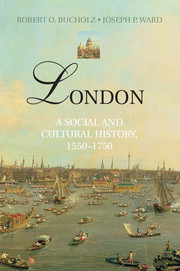Book contents
- Frontmatter
- Contents
- List of Illustrations and Maps
- List of Abbreviations and Conventions
- Acknowledgments
- Maps
- Introduction: London's Importance
- 1 London in 1550
- 2 The Socioeconomic Base
- 3 Royal and Civic London
- 4 Fine and Performed Arts
- 5 The Public Sphere and Popular Culture
- 6 The People on the Margins
- 7 Riot and Rebellion
- 8 Plague and Fire
- Conclusion: London in 1750
- Notes
- Further Reading
- Index
- Plate Section
4 - Fine and Performed Arts
Published online by Cambridge University Press: 05 November 2012
- Frontmatter
- Contents
- List of Illustrations and Maps
- List of Abbreviations and Conventions
- Acknowledgments
- Maps
- Introduction: London's Importance
- 1 London in 1550
- 2 The Socioeconomic Base
- 3 Royal and Civic London
- 4 Fine and Performed Arts
- 5 The Public Sphere and Popular Culture
- 6 The People on the Margins
- 7 Riot and Rebellion
- 8 Plague and Fire
- Conclusion: London in 1750
- Notes
- Further Reading
- Index
- Plate Section
Summary
If you were an artist or merely a lover of the arts and living in London in 1550, you had two main sources of patronage, inspiration, or entertainment: the court or the Church. From the Middle Ages to the dawn of our period, those two institutions dominated the world of high culture. First, the court and the Church had the vision to provide artistic programs and subjects for artists in London. Second, they commanded the financial resources to pay for both occasional commissions to artists in the form of buildings, paintings, statues, music, and literature, and to give them regular by-employment when new projects ran scarce. Thus, most of the great musicians of the day such as Thomas Tallis (c. 1505–1585) and William Byrd (c. 1543–1623) had positions as gentlemen of the Chapel Royal choir, or in one of the two great cathedral choirs in London, those of the Abbey or St. Paul's. Later in the century, stage players like William Shakespeare would be sworn into the service of the monarch or one of his great courtiers. Finally, the court and the Church provided large, national audiences, which led in turn to more attention for artists, wider dissemination of their works, and more commissions among the nobility. So, if you were a sixteenth-century artist and wanted to make a splash, you headed for London, and more specifically, to Whitehall, the Abbey, or the Cathedral.
But there was a price to be paid. What the court and Church gave with one hand, they limited – in subject matter, content and style – with the other. That is, the court and Church censored the arts: monarchs regulated their own images tightly, all printed works had to be approved by the bishops, and the Elizabethan stage was monitored by the master of the Revels in the lord chamberlain's office. Artistic expression in mid-sixteenth-century London, like trade, was unfree. It is thus perhaps fortunate that, although these institutions remained important cultural patrons throughout the period, their monopoly on subject matter and patronage was eroding. First, even before the Reformation, the great age of church building in London was largely over. After it, there was no more call for saintly statuary or stained glass; rather, these were removed on the orders of the Crown.
- Type
- Chapter
- Information
- LondonA Social and Cultural History, 1550–1750, pp. 132 - 163Publisher: Cambridge University PressPrint publication year: 2012



